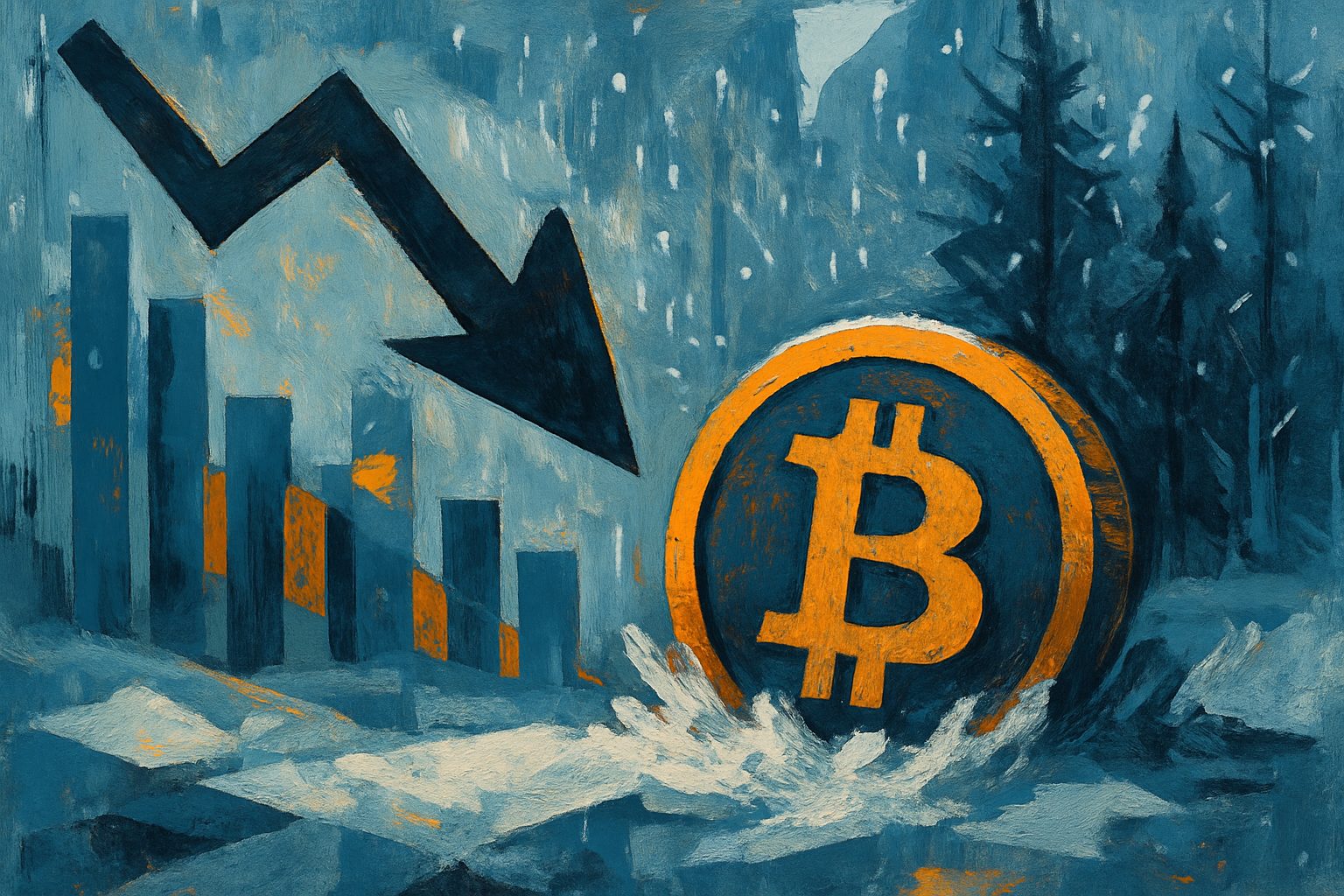
Navigating the Crypto Winter: Understanding Market Downturns and Their Impact
Dive into the chilling world of the crypto winter, where market downturns reshape the landscape of cryptocurrency. This article uncovers the factors behind these prolonged declines and analyzes how various cryptocurrencies respond, equipping investors with insights for future trends.
The world of cryptocurrency is often characterized by its relentless volatility, where fortunes can be made or lost in mere moments. Yet, amid this unyielding dynamism lies a recurring phenomenon known as the “crypto winter,” a chilling period marked by significant downturns in the market, disillusionment among investors, and an atmosphere of uncertainty. As this cyclical trend unfolds, understanding its intricacies becomes paramount for investors, analysts, and enthusiasts alike. This article delves deep into the essence of the crypto winter, exploring its underlying causes, the behaviors of various cryptocurrencies, and the implications for asset classes that experience fleeting surges of popularity.
Drawing on an extensive review of nine authoritative sources, this research meticulously investigates the factors contributing to the onset of a crypto winter, including market sentiment, regulatory shifts, and technological challenges. By examining how different cryptocurrencies respond during these downturns—especially those that may rise briefly on waves of hype only to falter in subsequent phases—this article aims to provide valuable insights into not only the cyclical nature of the crypto market but also the lessons it holds for future investments. As we navigate the complexities of this phenomenon, readers can expect a comprehensive analysis that sheds light on the resilience of certain assets and the vulnerabilities of others, equipping them with the knowledge to make informed decisions in an ever-evolving landscape.

Introductory Summary
The term crypto winter refers to a prolonged downturn in the cryptocurrency market, characterized by significant price declines, reduced trading activity, and a pervasive sense of pessimism among investors. This phenomenon can last for months or even years, often following a speculative bubble burst. Factors such as regulatory changes, macroeconomic conditions, and shifts in investor sentiment play a crucial role in triggering these winters. Historical instances, like the significant downturns witnessed in 2018 and 2022, highlight the cyclical nature of cryptocurrency markets. Understanding the dynamics of crypto winters is essential for navigating the complex landscape of digital assets. For a deeper dive into the topic, check out resources from TechTarget and BuiltIn.
A crypto winter is defined as a significant and prolonged decline in cryptocurrency prices. During these periods, which can last from several months to multiple years, we observe:
- Prolonged Price Drops: A sustained decrease in the value of various cryptocurrencies.
- Decreased Trading Activity: A notable drop in trading volumes.
- Low Investor Confidence: A general lack of interest in investing in the cryptocurrency market.
The term gained prominence after the major market downturn from late 2017 to 2018, where Bitcoin’s price fell from nearly $20,000 in December 2017 to around $3,000 by December 2018. The recent downturn from 2022 to 2023, marked by events like the collapse of TerraUSD and FTX, further exemplifies this trend, leading to billions in losses and a significant decline in market capitalization.
Key Factors Triggering a Crypto Winter
Understanding what leads to a crypto winter is crucial for investors. Here are some of the primary factors:
1. Macroeconomic Conditions
Rising inflation and increasing interest rates can negatively impact investor sentiment in the cryptocurrency market. For instance, actions taken by the U.S. Federal Reserve to combat inflation often correlate with declines in cryptocurrency prices, as seen during the 2022 crypto winter.
2. Market Sentiment and Speculation
Market sentiment can shift rapidly. Events such as high-profile scandals or significant losses can lead to a loss of confidence, triggering widespread sell-offs. The collapse of the TerraUSD and Luna tokens in May 2022 serves as a prime example of how swiftly sentiment can change.
3. Regulatory Changes
Regulatory crackdowns can have a chilling effect on the market. For example, the fallout from the FTX bankruptcy in late 2022 raised concerns about tighter regulations, exacerbating the downward trend.
4. Market Corrections and Bubbles
The cryptocurrency market is prone to speculative bubbles that eventually burst. The unsustainable price surges seen in 2021 led to a significant market correction in 2022, marking a crypto winter characterized by low prices and trading volumes.
5. Interconnectedness of Crypto Projects
The increasing interdependence among different cryptocurrencies can amplify crises. The downfall of a major player, such as FTX, can create a ripple effect throughout the entire market, deepening the crypto winter.
6. Technological Vulnerabilities and Security Breaches
Security issues, such as hacks and exploits, can significantly erode trust in the cryptocurrency ecosystem. High-profile breaches often lead to immediate sell-offs as investors seek to minimize their losses.
7. Decreased Institutional Participation
A reduction in institutional investment can signal market instability. When large players withdraw or reduce their exposure, it can create downward pressure on prices, as was evident during the 2022 crypto winter.
8. Decreased Trading Activity
A significant reduction in trading volume often accompanies crypto winters. This decline in activity can lead to reduced liquidity and further price declines, creating a feedback loop of decreased interest and falling prices.
Historical Occurrences of Crypto Winter
Examining historical crypto winters provides valuable insights into market behavior. Here’s a timeline of significant events:
| Year | Event Description |
|---|---|
| 2013 | Bitcoin rises to $1,000 in late 2013, driven by increased media attention and speculation. |
| 2014 | Mt. Gox Collapse: The major exchange filed for bankruptcy after losing approximately 850,000 Bitcoins due to hacking, leading to a significant loss of confidence in the market. |
| 2015 | Crypto market remains stagnant with Bitcoin’s price hovering around $200-$500, marking the end of the first crypto winter, which lasted from late 2013 to early 2015. |
| 2018 | Bitcoin’s Price Crash: Following a massive surge in 2017, Bitcoin’s price peaked at nearly $20,000 in December 2017 before crashing to around $3,200 in December 2018, marking a prolonged crypto winter that lasted until December 2020. |
| 2020 | The market begins to recover as institutional interest grows, leading to a renewed bullish phase in late 2020. |
| 2022 | TerraUSD and Luna Crash: In May, the collapse of the algorithmic stablecoin TerraUSD and its sister token Luna triggered a market-wide crisis, leading to significant losses across the crypto market. |
| 2022 | FTX Bankruptcy: In November, the collapse of the FTX exchange, coupled with allegations of fraud against its founder Sam Bankman-Fried, further eroded investor confidence and led to an estimated loss of $2 trillion in market capitalization since the height of 2021. |
| 2023 | The crypto winter continues into early 2023, with Bitcoin trading around $17,000 and Ethereum around $1,200, as regulatory scrutiny increases and investor sentiment remains low. |
The Significance of Crypto Winter
The implications of a crypto winter extend beyond mere price declines. Here are some key outcomes:
- Investor Behavior Changes: Investors are often faced with tough decisions—whether to hold their assets, exit the market, or buy more at lower prices.
- Market Consolidation: Weaker projects may falter, allowing stronger ones to emerge, leading to a more robust market post-winter.
- Regulatory Scrutiny: Increased scrutiny from regulators often follows downturns, prompting discussions on consumer protection and oversight.
- Innovation Opportunities: While many projects may fail, crypto winters can spur innovation as developers focus on sustainable solutions rather than chasing speculative profits.
Conclusion: Navigating a Crypto Winter
In summary, understanding the dynamics of a crypto winter is essential for anyone involved in the cryptocurrency market. Each downturn presents challenges and opportunities, and recognizing the signs of a crypto winter can help investors navigate periods of volatility. By staying informed and monitoring macroeconomic indicators, you can better position yourself for the next phase of the market. For further reading on the dynamics of crypto winters, you can explore sources like TechTarget, BuiltIn, and CNBC.
By understanding both the historical context and the underlying factors that contribute to the phenomenon of crypto winters, you can make more informed decisions in this ever-evolving landscape.
Vyftec – Navigating the Crypto Winter
At Vyftec, we specialize in providing precise research and analysis on trending phenomena like the Crypto Winter. Our team leverages advanced AI and machine learning solutions to dissect the intricate factors contributing to this market downturn, offering insights into how various cryptocurrencies and classes react during these challenging periods. With our expertise in data intelligence and web scraping, we ensure that you are equipped with actionable strategies to navigate market fluctuations and harness opportunities that arise from them.
Experience Swiss-quality consulting that is both innovative and reliable. Let us help you turn the challenges of the Crypto Winter into a pathway for future success. Reach out today to discuss how we can support your project!
📧 damian@vyftec.com | 💬 WhatsApp


